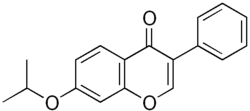Ipriflavone
Ipriflavone (INN, JAN; brand name Yambolap) is a synthetic isoflavone which may be used to inhibit bone resorption,[2] maintain bone density and to prevent osteoporosis in postmenopausal women.[1] It is not used to treat osteoporosis. It slows down the action of the osteoclasts (bone-eroding cells), possibly allowing the osteoblasts (bone-building cells) to build up bone mass.
 | |
| Clinical data | |
|---|---|
| Trade names | Yambolap |
| Other names | FLI13; 7-Isopropoxyisoflavone[1] |
| AHFS/Drugs.com | International Drug Names |
| ATC code | |
| Legal status | |
| Legal status |
|
| Identifiers | |
| |
| CAS Number | |
| PubChem CID | |
| ChemSpider | |
| UNII | |
| KEGG | |
| ChEMBL | |
| CompTox Dashboard (EPA) | |
| ECHA InfoCard | 100.125.854 |
| Chemical and physical data | |
| Formula | C18H16O3 |
| Molar mass | 280.323 g·mol−1 |
| 3D model (JSmol) | |
| |
| |
| | |
A clinical trial reported in 2001 that it was not effective in prevention or treatment of osteoporosis.[3]
A double-blind study reveals that ipriflavone might be effective on reducing tinnitus on otosclerosis sufferers.[4]
Ipriflavone has been described as a phytoestrogen.[5] However, this is incorrect, as the drug does not bind to or activate the estrogen receptor and shows no estrogenic effects in postmenopausal women.[6][7] The drug prevents bone loss via mechanisms that are distinct from those of estrogens.[5]
References
- Elks J (14 November 2014). The Dictionary of Drugs: Chemical Data: Chemical Data, Structures and Bibliographies. Springer. pp. 651–. ISBN 978-1-4757-2085-3.
- Civitelli R (1997). "In vitro and in vivo effects of ipriflavone on bone formation and bone biomechanics". Calcified Tissue International. 61 Suppl 1: S12-4. doi:10.1007/s002239900378. PMID 9263610.
- Alexandersen P, Toussaint A, Christiansen C, Devogelaer JP, Roux C, Fechtenbaum J, et al. (March 2001). "Ipriflavone in the treatment of postmenopausal osteoporosis: a randomized controlled trial". JAMA. 285 (11): 1482–8. doi:10.1001/jama.285.11.1482. PMID 11255425.
- Sziklai I, Komora V, Ribári O (1992). "Double-blind study on the effectiveness of a bioflavonoid in the control of tinnitus in otosclerosis". Acta Chirurgica Hungarica. 33 (1–2): 101–7. PMID 1343452.
- Arjmandi BH, Birnbaum RS, Juma S, Barengolts E, Kukreja SC (January 2000). "The synthetic phytoestrogen, ipriflavone, and estrogen prevent bone loss by different mechanisms". Calcified Tissue International. 66 (1): 61–5. doi:10.1007/s002230050012. PMID 10602847.
- Petilli M, Fiorelli G, Benvenuti S, Frediani U, Gori F, Brandi ML (February 1995). "Interactions between ipriflavone and the estrogen receptor". Calcified Tissue International. 56 (2): 160–5. doi:10.1007/BF00296349. PMID 7736326.
- Melis GB, Paoletti AM, Cagnacci A, Bufalino L, Spinetti A, Gambacciani M, Fioretti P (November 1992). "Lack of any estrogenic effect of ipriflavone in postmenopausal women". Journal of Endocrinological Investigation. 15 (10): 755–61. doi:10.1007/BF03347647. PMID 1491124.
External links
- Ipriflavone at PDR Health